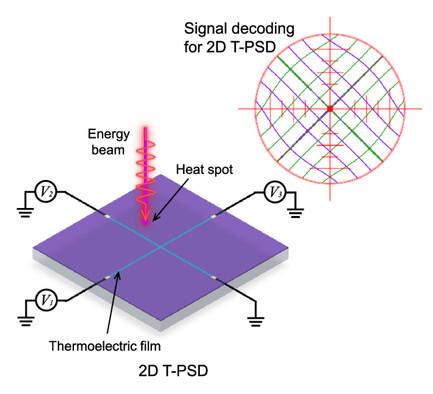Thermal Sight: A Position-Sensitive Detector for a Pinpoint Heat Spot
IF 11.1
Q1 MATERIALS SCIENCE, MULTIDISCIPLINARY
引用次数: 0
Abstract
Precise positioning is a never-ending goal in both fundamental science and technology. Recent decades of advancements in high-precision position detection have predominantly relied on photoelectric effects for light detection in semiconductors. Herein, a different approach is proposed: The thermoelectric-based position-sensitive detector (T-PSD) concept is designed to detect single heat spots arising from various energy sources, including electromagnetic radiation, electrons, and macroscopic mechanical heat. The T-PSD concept is initially derived mathematically from the fundamental principles of heat conduction and the Seebeck effect. Subsequently, it is proved by finite element simulation in both 1D and 2D configurations. Following this theoretical groundwork, T-PSD prototypes are fabricated and subjected to positional detection using various stimuli such as CO2 laser beam, hot soldering tip, and electron beam. In the prototypes, structured aluminum-doped zinc oxide thermoelectric thin films, prepared via atomic layer deposition, are outfitted with voltage probes, enabling the measurement of thermoelectric voltages as a function of position and the intensity or temperature of the heat spot. Furthermore, practical decoding strategies are introduced to infer the position from the measured signals. The T-PSD in this article showcases considerable promise in high-precision position detection such as (quasi-)particle tracking and precision machinery, offering an alternative concept in PSD design.

红外热像仪精确定位热斑的位置敏感探测器
精确定位是基础科学和技术领域永无止境的目标。近几十年来,高精度位置检测技术的发展主要依赖于半导体中光检测的光电效应。本文提出了一种不同的方法:基于热电的位置敏感探测器(T-PSD)概念旨在探测由各种能量源(包括电磁辐射、电子和宏观机械热)产生的单个热斑。T-PSD 概念最初是根据热传导和塞贝克效应的基本原理从数学上推导出来的。随后,通过一维和二维配置的有限元模拟对其进行了证明。在此理论基础上,我们制作了 T-PSD 原型,并使用二氧化碳激光束、热焊尖和电子束等各种刺激进行位置检测。在原型中,通过原子层沉积制备的结构化掺铝氧化锌热电薄膜配备了电压探头,可以测量热电电压与位置和热斑强度或温度的函数关系。此外,还介绍了实用的解码策略,以便从测量信号中推断位置。本文中的 T-PSD 在高精度位置检测(如(准)粒子跟踪和精密机械)方面大有可为,为 PSD 设计提供了另一种理念。
本文章由计算机程序翻译,如有差异,请以英文原文为准。
求助全文
约1分钟内获得全文
求助全文
来源期刊
CiteScore
14.00
自引率
2.40%
发文量
0
期刊介绍:
Small Science is a premium multidisciplinary open access journal dedicated to publishing impactful research from all areas of nanoscience and nanotechnology. It features interdisciplinary original research and focused review articles on relevant topics. The journal covers design, characterization, mechanism, technology, and application of micro-/nanoscale structures and systems in various fields including physics, chemistry, materials science, engineering, environmental science, life science, biology, and medicine. It welcomes innovative interdisciplinary research and its readership includes professionals from academia and industry in fields such as chemistry, physics, materials science, biology, engineering, and environmental and analytical science. Small Science is indexed and abstracted in CAS, DOAJ, Clarivate Analytics, ProQuest Central, Publicly Available Content Database, Science Database, SCOPUS, and Web of Science.

 求助内容:
求助内容: 应助结果提醒方式:
应助结果提醒方式:


